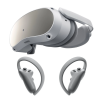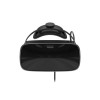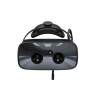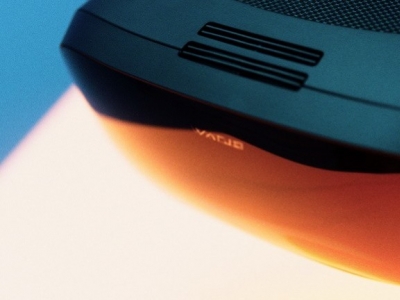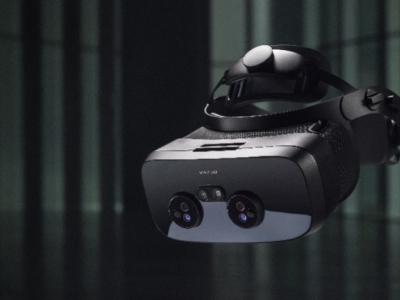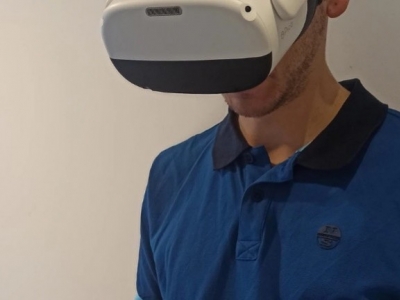Guide to choosing a VR/XR/AR 
Virtual reality (VR), augmented reality (AR) or mixed reality (MR) has become an increasingly popular technology for entertainment, education, training and business. By wearing a 360° immersive headset, you can have a fully immersive experience thanks to the very high resolution screens.
However, with so many choices from well-known manufacturers such as Meta (ex-Oculus), Microsoft, HTC VIVE, Pico, HP, Lynx, choosing the right VR/AR headset can be difficult.
This guide outlines the essential elements to consider when choosing the right headset based on your goals and the hardware you already have. Find out how to compare AR/VR headsets by taking into account screens, field of view (FOV), cables, speed and lag for the best experience.
What types of headsets
It is important to understand the differences between AR, VR and MR headsets before making a choice.
VR, or virtual reality headsets completely immerse the user in an artificial environment. They are ideal for games and immersive experiences where the user is completely cut off from reality.
AR headsets, or augmented reality, add digital elements to the user's real environment. They are often used for practical applications such as professional training or industrial maintenance.
Finally, XR or mixed reality headsets are a combination of both, offering both an immersive and augmented experience. It is important to consider the intended use of the headset to choose the most suitable type for your needs.
How to choose the right VR/AR/MR headset
The virtual reality industry is constantly evolving, with new announcements and innovative technologies emerging regularly. To choose the right headset for your needs, it is important to consider several key features.
Here are the main features to consider when choosing a VR/AR headset:
Screens:
For an immersive and realistic virtual reality experience, it is important to consider the resolution and refresh rate of the screen. Go for high numbers, but don't forget to take into account the pixel density, which is determined by the screen size and resolution.
Field Of Vision (FOV):
The field of view (FOV) characteristic is essential when choosing a VR/AR/XR headset as it determines the size of the image that can be seen through the device. Measured in degrees, the FOV varies from headset to headset, with some offering 90 degree vision while others can go up to 120 degrees. The wider the field of view, the greater the immersion in the virtual environment and the more realistic the experience. It is therefore important to take this feature into account when purchasing a VR/AR/XR headset, depending on how you want to use it.
Cables:
The major difference between VR headsets is their connection: standalone or wired.
- Standalone headsets: Standalone VR headsets, such as the Meta Quest or VIVE Focus 3, have their own computing unit and offer greater freedom of movement, as they do not need to be connected to a computer or console by cable. Some standalone headsets can also be connected to a PC via a cable or wirelessly to take advantage of the extra performance offered by the PC.
- Wired headsets: Wired VR headsets are designed to be used with a powerful PC and require a cable to connect the headset to the computer. This wired connection can limit your movement, but some wired headsets can be connected wirelessly to a PC using a special transmission device. Thus, the advantages and disadvantages of stand-alone and wired headsets should be weighed up according to the user's needs and preferences.
Latency and performance:
Latency is an important element for a smooth and comfortable experience. It depends on the hardware and content, and is not directly related to the headset. However, the processing power of your PC or game console can influence latency and performance. For example, a wired headset, connected to a powerful system, may offer better performance than a standalone headset, although the refresh rate of the screens is also a key factor. It is therefore essential to consider the specifications of the hardware and content to minimise latency and optimise the user experience.
Pro and consumer uses: advantages and disadvantages of solutions?
Choosing the perfect virtual, augmented or mixed reality headset depends on a crucial question: which headset for which use? Each technology has its strengths and limitations, which we will explore in this section.
Professional use:
The choice of a headset depends on the intended professional use. For maintenance or remote assistance operations, augmented reality headsets like the Realwear HMT-1 are interesting. They bring information into the operator's field of view which is interesting for following step-by-step instructions, even if the expert's remote interaction is limited.
For contexts where the operator needs to be guided precisely or in collaborative situations, mixed reality headsets, such as HoloLens 2 or Magic Leap 2, offer an extra dimension by superimposing the virtual on the real. Their "optical see-through" technology allows you to see the world naturally and without distortion. However, their field of vision is reduced and the virtual objects cannot obscure the real. Interesting for many uses where it is important to guide an operator with precision and in collaborative contexts to facilitate communication between stakeholders
Standalone VR headsets such as Pico G3, Pico 4 and Quest 2 currently have limited computing capacity. This applies to all autonomous headsets, including the HL2, although advances in the performance of on-board chips and processors are promising. With WiFi 6 and the expertise of 5G networks, this constraint could be overcome in the future with Cloud XR, which offloads computing power to the cloud. These VR headsets stand out for their wide deployment in companies due to their affordable cost. They are widely used for training and events. However, their management by corporate IT departments poses a problem (problem linked to MDM/VRDM), a difficulty that could soon be overcome.
Wired VR headsets such as the Valve Index, Vive Pro, Reverb G2 and Varjo VR-3 face intense competition from stand-alone headsets. The latter can connect to a PC, thus benefiting from high computing power, and they do not require external tracking tags like some models. The Varjo VR-3 perhaps still stands out, thanks to its high pixel density, which makes it particularly suitable for product design. However, the Varjo VR-3 faces competition from its bigger brother, the more versatile XR-3. It is likely that this category of headsets will be on the way out in the coming years.
In the wired XR category, the Varjo XR3 is the ultimate immersive experience. Designed primarily for design and simulation, this headset is distinguished by its high-fidelity displays that offer unparalleled visual quality. Its attributes don't stop there, and its other strengths make it a top choice for those seeking an uncompromising VR experience.
Finally, the standalone XR headset sector, with models like the Lynx R-1, Vive XR Elite, Quest Pro and Lenovo VR-X, is currently booming. While the experience offered by these headsets is not yet as mature as the HoloLens 2 in terms of mixed reality, they stand out as having a more diverse range of potential uses. Most manufacturers are looking to make their mark in this area. It is important to note that, compared to the HL2, the video see-through technology of these devices allows for a greater range of vision and the projection of virtual objects that can obscure reality. Thus, despite their areas for improvement, these stand-alone XR headsets have undeniable strengths.
Consumer use:
Having explored the business applications of VR headsets, let's now look at how these innovative technologies are being adopted and used by the general public, for applications ranging from video games to immersive world discovery.
In the field of gaming, stand-alone VR headsets such as the Quest 2 and Pico are particularly interesting. They offer a wide range of applications and games, all at a fairly affordable cost. Playstation VR is also an option to consider, although it is still a long way off and the price for the range of games is not convincing.
For those with a powerful PC, wired VR headsets were usually the best option. However, as mentioned earlier, a standalone wired VR headset now offers the best value for money on the market today.
For simulation enthusiasts, the Varjo Aero is a notable option, while for the more affluent, the Varjo VR-3 or XR-3 are preferred choices. Although this is a niche market, it caters for a very demanding audience for whom quality and realism of rendering are essential, particularly for the legibility of information in a virtual cockpit.
Standalone XR headsets could soon offer new and original gaming experiences, although they are not yet priced for the general public. Apple could potentially open up new uses for the general public.
Finally, in education, the XR has a lot of potential to offer enriching experiences. However, it is important to note that these XR headsets are not recommended for children under the age of 13 whose optical system is not yet fully mature.
An expert's opinion: Meeting with an Immersion specialist
We had the pleasure of speaking with Marc Audonnet, virtual reality expert and prominent member of the Immersion and Cornershop team, to get some insight into the evolution of the demand for VR headsets, the future of wired headsets and the options available for large industries looking for standalone solutions. Here are his answers, which are sure to enlighten our readers about VR headsets and their many applications.
How is the demand for VR headsets changing?
"The evolution of demand for headsets is moving more and more towards cable-free and more compact standalone solutions, thus increasing technological acceptance by users."
We're seeing a shrinking catalogue of wired headsets, is this the end of the wired headset?
"No, we mustn't forget that these fully embedded technologies are not yet easy to deploy in increasingly secure IT infrastructures. So, wired headsets still persist in large industries to this day, especially as they allow for much better visualisation qualities in terms of digital mock-ups."
So, is it possible today for a large industrialist to choose a standalone headset?
"It is entirely possible, depending on the intended use within the group, either in stand-alone mode after qualifying the necessary level of security, or in 'stream' mode, which consists of using the helmet as a display device without using the onboard computer. In this case, there are two possibilities: 'Wired Stream' via USB or 'WiFi Stream' with a dedicated WiFi 6 network."
What headsets are available in the cornershop ?
If you are looking for a quality AR/VR/XR headset for your personal or professional projects, the Cornershop by Immersion can equip you or inform you.
Here are some of the headsets available on the website:
The brand's helmets HTC VIVE :
The brand's helmets Pico :
The brand's helmets Varjo :
The brand's helmets Lynx :
The brand's helmets HP :
Essential accessories : What types?
We will discuss the different types of accessories available for VR/AR headsets. There are a multitude of accessories to enhance your immersive experience. Among the most popular are wireless adapters such as the Wireless Adapter for VIVE Pro, which gets rid of cables for greater freedom of movement.
Trackers :
Trackers are also very useful for tracking the movements of your real objects in the virtual environment such as the VIVE Tracker 3.0, Vive Tracker Connector. Trackers can be placed on any object, such as your back or feet, for more accurate and professional motion analysis.
Suits :
Virtual reality suits allow for total immersion in a virtual environment by capturing full body movements. These suits are equipped with sensors and haptic feedback to add tactile sensations, physical exertion, weight, heat or cold sensations, and much more. For example, the Neuron Perception 3 or PN3 with its ultra-precise sensors and integrated haptic feedback, the PN3 allows for a superior immersive virtual reality experience, tracking body movements with great precision.
Haptic gloves :
Haptic gloves allow users to receive real-time haptic feedback when interacting with virtual objects. Some models also offer precise tracking of hand movements, which allows for an even more realistic immersive experience. The haptic feedback of the gloves allows you to feel the texture and weight of the virtual objects, adding an extra level of realism to the experience.
It is important to mention that not all haptic gloves are equipped with hand movement tracking. To begin with, it is recommended to talk about tracking gloves for hand tracking (some headsets such as Meta Quest 2/Pro, Hololens and Pico 4 already offer this functionality). Then, it is possible to focus on haptic gloves and their ability to offer haptic feedback for an even more realistic immersive experience.
Hygiene:
Finally, it is important to consider the hygiene aspect of your VR/AR equipment and headset. Hygiene accessories allow you to clean the contact surfaces regularly and limit dirt for a more pleasant and hygienic experience. In short, there are many accessories for VR/AR headsets that can greatly enhance your experience.
Please feel free to contact us by email or phone if you need more information about our VR/AR/XR headsets or if you have specific questions about choosing the right headset for your needs.
Tips for a better AR/VR/XR experience
Here are some tips to improve your AR/VR/XR experience:
- Upgrade your equipment: Make sure your PC is powerful enough to support VR and AR headsets that require a PC connection. Upgrade your graphics card and processor if necessary.
- Create a dedicated gaming space: For the best gaming experience, create a dedicated space where you can move freely without worrying about obstacles. This will allow you to fully immerse yourself in the experience.
- Adjust your headset correctly: For optimal comfort and a better viewing experience, adjust the position and tightness of your headset correctly. Also make sure the lenses are clean.
- Take regular breaks: To avoid eyestrain and headaches, it is recommended to take regular breaks when using an AR/VR/XR headset.
- Explore different apps and games: To get the most out of your AR/VR/XR headset, try different apps and games that make the most of the headset's capabilities.
By following these tips, you're on your way to getting the most out of your AR/VR/XR experience and getting the most out of your headset.
The best XR/AR/VR headsets on the market:
Here are some of the most popular and best performing headsets available on the market.
Oculus/Meta Quest 2 :
The Meta Quest 2 is an all-in-one VR headset designed to deliver an immersive gaming experience with smooth performance and next-generation graphics. It offers a resolution of 1832 x 1920 pixels per eye and features enhanced Oculus Touch controllers for natural interaction. The Meta Quest 2 is an affordable and easy-to-use headset that can operate as a standalone, wired (Link) or Wi-Fi (Air Link) headset.
It also comes with many accessories such as Elite Strap with battery, Meta Quest Link Cable, Protective Case, Silicone Cover, Fit Pack and many more.
The advantages of the Oculus Quest 2 include:
✅Its ease of installation,
✅Its portability,
✅ Its affordable price
✅The quality of its screen.
Disadvantages include:
❌ Requires a Meta account to operate
❌ The life of the battery is limited.
Microsoft hololens 2
The Microsoft HoloLens 2 is an AR headset designed for professionals and businesses. It features a 2048 x 1080 pixel holographic display, a 52-degree field of view and a 60 Hz refresh rate. It allows hand and eye tracking, as well as interaction with holograms in real time.
It also has many accessories such as charger and USB-C Cable, Carrying Case, Reviiiew License (12 months), Construction/Safety Headset, Trimble XR10 Headset and many more.
Benefits:
✅ Provides an advanced AR experience,
✅ Better ergonomics,
✅ Higher resolution
✅ Precise tracking of movements.
✅ Particularly suitable for industrial and training applications.
Disadvantages:
❌ Its high price
❌ Its professional orientation makes it less suitable for the general public.
Pico 4 Enterprise
The Pico 4 Enterprise is a standalone 6DoF VR headset designed for businesses by Chinese manufacturer Pico, supported by ByteDance. The headset is the successor to the popular Pico Neo 3 Pro VR and offers a 4K+ display with Pancake lenses, providing superior display quality. It is specifically designed for interactive training, hospitality and simulation. Notable features include Sideloading, a dedicated App Store, face and eye tracking, Pico Business Suite and PU face protection.
The Pico 4 Enterprise offers a next-generation VR experience with accurate face, eye and hand tracking. It is ideal for healthcare professionals and educators. Its 5300 mAh battery life allows up to three hours of use with fast charging capability. However, its price and corporate focus may make it less accessible to the general public.
Benefits :
✅ Precise monitoring of the face, eyes and hand
✅ Ideal for health professionals and educators
✅ 3 hours of use
✅ fast charging capability
Disadvantages :
❌ The price is quite high.
❌ Its focus on business may make it less accessible to the general public.
❌ Need to use a Bluetooth headset for better sound quality
Varjo XR3
The Varjo XR-3 is an augmented and virtual reality headset designed to deliver stunning image quality through high pixel density and passthrough video camera technology. This headset embeds new cameras for Inside-out tracking, LiDAR, as well as UltraLeap™Gemini (v5) technology for natural hand interactions and 3D content.
Benefits:
✅ Provides better environmental and interaction management with a LiDAR RGB camera.
✅ A refresh rate of 90 Hz.
✅ One of the fastest and most accurate eye-tracking systems in the world, up to 200 Hz.
✅ Adjustable headband, light weight and active cooling improve comfort and ease of use
Disadvantages:
❌ Its rather high price.
❌ The licences required for access to proprietary software could be a barrier for some users.
Varjo Aero :
The Varjo Aero is a high-end virtual reality device that offers clear, high resolution and built-in eye tracking. It features dual mini-LED displays for exceptional clarity and a 115 degree field of view. The Aero headset is lightweight, comfortable and ergonomically designed.
Benefits:
✅ High resolution of 2880 x 2720 pixels per eye.
✅ Can be used with a laptop
✅ Offers industry-leading visual fidelity with a resolution of 35 pixels per degree, ideal for professionals and high-end VR enthusiasts.
✅ The headset is compatible with SteamVR content, including popular games.
✅ Integrated eye tracking allows for more accurate interactions and analysis, as well as foveal rendering that reduces computational requirements.
Disadvantages:
❌ Narrower field of view (115°) compared to the HTC Vive Pro 2 (120°)
❌ Requires a powerful PC
❌ The price of the Varjo Aero makes it less affordable than some other VR headsets for casual users and beginners.
Meta quest pro
The Meta Quest Pro is a standalone, high-end virtual reality headset, offering a mixed reality experience through cameras and depth sensors. It has 256GB of storage capacity, a resolution of 1800 x 1920 pixels and a 110° field of view. The headset is thinner, better balanced and designed for long-lasting comfort.
Benefits:
✅ Stand-alone use, no need to connect to a PC.
✅ Mixed reality collaboration, even from a distance.
✅ Large storage capacity of 256 GB.
✅ Balanced and comfortable design for extended use.
✅ Smaller and improved controllers with better haptic feedback and tracking.
Disadvantages:
❌ Potentially less affordable than other VR headsets for casual users and beginners.
❌ Slightly smaller field of view than the Varjo Aero.
❌ Low battery life.
HTC vive XR elite
The HTC VIVE XR Elite is a versatile and customizable virtual reality headset designed to provide optimal comfort even during extended use. Thanks to its light weight and connectivity options, you can enjoy the VR experience wirelessly (Wi-Fi 6E) or by connecting it to a PC (USB-C). Equipped with a dedicated graphics chip, the VIVE XR Elite offers a resolution of 3840 x 1920 pixels and a refresh rate of 90 Hz, ensuring total immersion in virtual reality.
Benefits:
✅ The best mixed reality to date
✅ Lightweight and comfortable for extended use
✅ Wireless (Wi-Fi 6E) or wired (USB-C) connection for optimal experience
✅ High resolution (3840 x 1920 pixels) and 90 Hz refresh rate for total immersion
✅ Can be transformed into unique, lightweight VR glasses
✅ Hand tracking for intuitive interaction with compatible games and applications
Disadvantages:
❌ Tracking accuracy and spatial awareness dependent on lighting conditions
❌ Depth sensor functionality limited to indoor environments
❌ Need for an alternative power source of 18 W or more when the battery holder is disconnected
❌ Limited battery life (2 hours continuous use)
Lynx R1 :
The Lynx R1 headset features six cameras that allow for precise tracking of 6DoF position and hand movement. The newly designed lens ensures a smooth and realistic AR experience, while maintaining a compact form factor. The headset is also comfortable with a halo headband and a lightweight faceplate that can be flipped up 90 degrees for quick access to the real world.
Benefits:
✅ The best mixed reality to date
✅ Data sovereignty for better privacy
✅ Open platform with access to sensor data via SDK
✅ Comfortable with a small form factor and a halo headband
✅ AR colour pass-through mode for immersive augmented reality
✅ Works in stand-alone mode or in connection with a PC
Disadvantages:
❌ Tracking accuracy and spatial awareness dependent on lighting conditions
❌ Release date still uncertain.
❌ Potentially less content and application compatibility than more established VR/AR headsets
❌ Battery life and hand tracking performance unknown at this stage
The Pico G3 :
The Pico G3 is a standalone 3DOF VR headset designed to offer powerful performance, a 4K display and a Snapdragon XR2 chipset. It is particularly suited to businesses with specific needs, thanks to its affordable price, ease of use and speed of delivery. With its many features and technical specifications, the Pico G3 is a good choice for professionals looking for a high-quality, high-performance VR headset.
The benefits of the Pico G3 include:
✅ Powerful performance with the Snapdragon XR2 chipset
✅ 4K display for a high-quality visual experience
✅ Optimized comfort and ergonomics
✅ Open Android system for advanced customization
✅ Security and reliability suitable for professional use
Among the disadvantages:
❌ Limited battery life of 2.5 hours
❌ Less suitable for consumer games and experiences
❌ 3DOF VR headset, offering less immersion compared to 6DOF headsets
In conclusion:
In summary, choosing the right headset for Virtual Reality or Mixed Reality can be a complex task given the many options on the market. At Cornershop By Immersion, we are here to assist you in this task and help you choose the headset that best suits your needs and budget.
As a specialised provider of XR solutions, we offer a wide range of headsets and equipment for virtual reality and augmented reality. Our expertise and experience in this field allows us to advise you on the best options and provide you with a personalised service that meets your expectations. Our goal is to become your preferred partner in XR technology, providing you with the tools and resources you need to get the most out of these immersive experiences. Whether it's gaming, professional development or remote collaboration, we're here to support you and guide you on your journey.
If you would like more information or have specific questions about our products and services, please contact us directly.
To contact us :
- ✉ You can send us an email: cornershop@immersion.fr
- You can fill in our contact form available on our website by clicking here.
Our team of experts will be happy to respond as soon as possible and provide you with all the information you need to make the best choice for XR hardware.
FAQ :
What is the difference between virtual reality (VR), augmented reality (AR) and mixed reality (XR)?
Virtual reality (VR) immerses the user in an artificial environment, while augmented reality (AR) adds digital elements to the user's real environment. Mixed reality (XR) is a combination of the two, offering both an immersive and augmented experience.
What are the main factors to consider when buying an AR/VR/XR headset?
Key factors to consider when purchasing an AR/VR/XR headset include resolution, field of view (FOV), cables, speed, lag and headset type
Do all VR headsets work with all VR games and applications
No, not all VR headsets are compatible with all VR games and applications. Games and applications are often developed specifically for one platform or headset. However, some platforms, such as SteamVR, are compatible with a wide range of headsets, which increases the library of games and applications available.
Do I need a powerful PC to use a VR or AR headset?
Some headsets, such as Meta Quest 2 and Microsoft HoloLens 2, are standalone and do not require a PC to operate. However, VR and AR headsets that work with a PC, such as HTC VIVE Cosmos and HP Reverb G2, generally require a powerful PC to provide the best experience.
Can a VR headset be used to watch 3D movies and videos?
Yes, most VR headsets can be used to watch movies and videos in 3D. There are specific applications for this, such as Netflix VR, YouTube VR or third-party 3D video players. These applications offer an immersive movie experience by creating a virtual cinema environment.
What is the best headset for VR gaming?
The Meta Quest 2 is the best choice for VR gaming because of its large library of games and ease of use.

